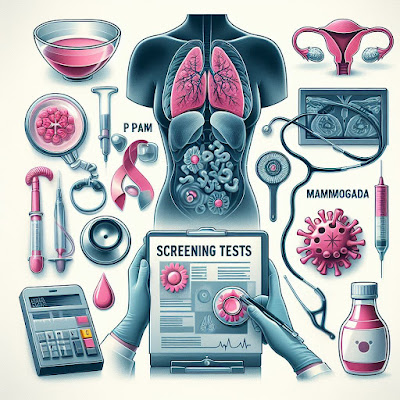Introduction: Unlocking the Power of Prevention
In the realm of healthcare, prevention is often heralded as the cornerstone of well-being. One crucial aspect of preventive care is screening tests, which play a pivotal role in detecting diseases at early stages when treatment is most effective. In this comprehensive blog post, we delve into the world of screening tests, focusing on widely recognized tests such as Pap smears and mammograms. Join us as we explore the significance of these tests, their impact on health outcomes, and the importance of regular screenings in maintaining overall wellness.
 |
| Screening Tests |
Understanding Screening Tests: What Are They and How Do They Work?
Screening tests are medical examinations or procedures performed to detect the presence of a disease or condition in individuals who do not have symptoms. The goal of screening is to identify diseases at their earliest stages, allowing for prompt intervention and improved outcomes. Screening tests vary widely depending on the disease or condition being targeted and may include laboratory tests, imaging studies, or physical examinations. These tests are designed to be sensitive enough to detect abnormalities while minimizing false-positive results.
The Role of Pap Smears in Cervical Cancer Screening
One of the most well-known screening tests is the Pap smear, also known as Pap test or cervical cytology.
This simple procedure involves collecting cells from the cervix to examine for abnormalities that may indicate cervical cancer or precancerous changes. Cervical cancer is highly preventable and curable when detected early through routine Pap smears. By identifying abnormal cells early on, healthcare providers can recommend further evaluation or treatment to prevent the progression of cervical cancer.Mammograms: A Vital Tool in Breast Cancer Detection
Another essential screening test is the mammogram, an X-ray of the breast used to detect breast cancer in its early stages. Mammography is recommended for women starting at age 40 or earlier if they have risk factors for breast cancer. Regular mammograms can detect breast cancer before symptoms develop, significantly improving the chances of successful treatment and survival. While mammograms may cause discomfort for some women, the benefits of early detection far outweigh any temporary discomfort or inconvenience.
Navigating Guidelines and Recommendations
It's essential to note that screening recommendations may vary based on individual risk factors, age, and medical history. Healthcare providers rely on evidence-based guidelines to determine the most appropriate screening schedule for each patient. As such, it's crucial for individuals to discuss their screening needs with their healthcare provider and make informed decisions based on their unique circumstances. By staying informed and proactive about screening recommendations, individuals can take charge of their health and well-being.
Looking Ahead: Innovations in Screening Technology
Advancements in technology continue to revolutionize the field of screening tests, offering new tools and techniques for disease detection and prevention. From molecular diagnostics to artificial intelligence-driven imaging, these innovations hold the promise of making screening tests more accurate, accessible, and personalized. As researchers and healthcare professionals continue to push the boundaries of medical science, the future of screening tests looks brighter than ever, offering hope for earlier detection and improved outcomes for individuals worldwide.
Conclusion: Prioritizing Prevention for a Healthier Future
In conclusion, screening tests are invaluable tools for preventing and detecting diseases at their earliest stages. From Pap smears to mammograms and beyond, these tests empower individuals to take control of their health and well-being by identifying potential health concerns before they become serious. By prioritizing regular screenings and following evidence-based recommendations, we can work together to promote a culture of prevention and ensure that everyone has the opportunity to live a long, healthy life.







